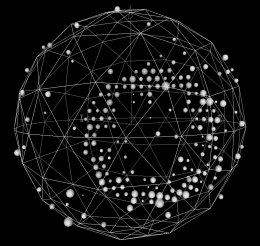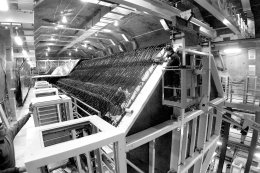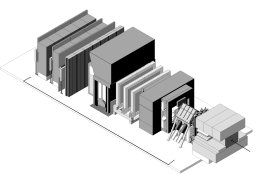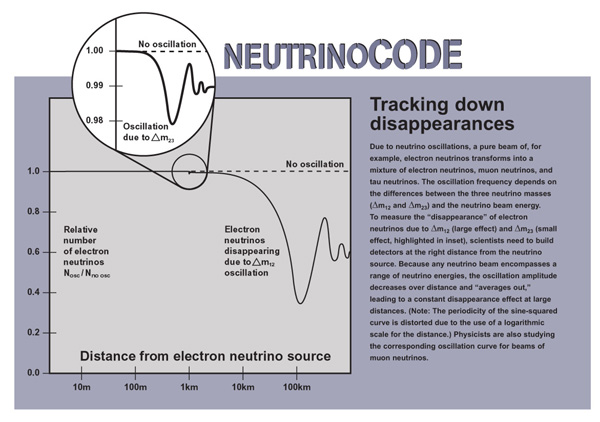 |
|
Cracking the Neutrino Code by Kurt Riesselmann
Neutrinos are everywhere. Capable of traversing the entire earth at close to the speed of light, these particles shine no light, and only very rarely does one of them interact with anything at all. Penetrating every corner of the universe, billions of neutrinos cross your body in a tiny fraction of a second. From its very beginning, Fermilab (originally called the National Accelerator Laboratory) has helped to unravel the secrets of these ghost-like particles. The first experiment at NAL, labeled E1A and proposed in June 1970, used neutrinos to search for a force-carrying particle called the W boson.Since that time Fermilab has conducted numerous neutrino experiments. In recent years both the DONuT collaboration (first direct observation of the tau neutrino, July 2000) and the scientists of the NuTeV experiment (precision measurement of an electroweak-force parameter, November 2001) have created headlines with their scientific results. In the next five years, Fermilab’s contributions to the worldwide neutrino research efforts will come from two new experiments. In September, 2002 the 19-million-dollar MiniBooNE detector began taking data on neutrino collisions,and in early 2005 the 171-million-dollar NuMI project will send neutrinos produced by Fermilab accelerators to the MINOS detector in Soudan, Minnesota. Thanks to these experiments Fermilab will continue to be one of a handful places in the world to play a major role in revealing neutrino secrets in the years to come. Predicted by theorist Wolfgang Pauli in 1930, the neutrino resisted direct experimental evidence until the 1950s, when a Nobel Prize-winning experiment at a nuclear reactor at the Savannah River Plant, South Carolina recorded the first neutrino interactions with matter. Over the last fifty years scientists have identified three types of neutrinos: electron neutrinos,muon neutrinos,and tau neutrinos, all considered to be massless. It wasn’t until results from the Japanese Super-Kamiokande experiment in 1998 that the scientific community realized that neutrinos do have mass.
WHEN A SPORTS CAR
BECOMES A MINIVAN
The discovery of neutrino mass, however, created many new questions. Massive neutrinos show a peculiar behavior: neutrino oscillations,the in-flight transformation of one type of neutrino into another. Completely unknown in the macroscopic world, this quantum effect is equivalent to a sports car morphing into an SUV or perhaps a minivan, only to change back into a sports car many miles farther down the road. If a highway initially featured only sports cars, it would soon be populated with a mixture of all three types of cars. Last year, advances in neutrino oscillation research created headlines in newspapers and magazines all over the world. The Sudbury Neutrino Observatory in Canada reported results on solar neutrino oscillations, the transformation of electron neutrinos emitted by the sun into the two other types of neutrinos. The Japanese KamLAND experiment observed the “disappearance” of electron neutrinos emitted from several nuclear reactors. These disappearances were again attributed to neutrino oscillation.The K2K experiment, which analyzes a beam of muon neutrinos produced by an accelerator 250 kilometers away at the KEK laboratory in Japan, saw indications for the transformations of those accelerator-made neutrinos, too. Topping off last year’s neutrino success stories, two neutrino scientists shared half of the 2002 Nobel Prize in physics for their pioneering work in detecting cosmic neutrinos. Beginning in the 60s, Ray Davis conducted a groundbreaking 30-year-long experiment to detect solar neutrinos in a gold mine in Homestake, South Dakota. Masatoshi Koshiba headed the Kamiokande experiment in a zinc mine in the Japanese Alps, confirming Davis’s results. In 1987, the Kamiokande experiment stunned the world by recording neutrinos emerging from a distant supernova explosion. “2002 has been a miracle year for neutrino physics,” said Maury Goodman, physicist at Argonne National Laboratory and publisher of the electronic Long-Baseline Neutrino Newsletter. “Now there is a huge amount of effort,thinking about future neutrino experiments.”
ARE THERE THREE OR FOUR?
“It’s hard to make progress in neutrino physics without resolving the LSND question,” said John Beacom, astrotheorist at Fermilab. “No experiment other than MiniBooNE is touching that. The KARMEN experiment [conducted a few years ago in England ] didn’t have the sensitivity to fully test the LSND results. If MiniBooNE confirms LSND, then either there are sterile neutrinos or something else at least that dramatic for physics and astrophysics.” Taking into account all experimental results from around the world, the data obtained by the LSND collaboration suggests the presence of four neutrinos. Theorists refer to the extra neutrino, which must be even less interactive than the three standard neutrinos, as the sterile neutrino. By conducting an independent measurement in the next few years, the BooNE collaboration will either confirm or refute the LSND results. If the initial MiniBooNE experiment confirms the LSND oscillation effect, scientists hope to build a larger detector,called BooNE, to study the effects of the sterile neutrino in detail.
MINOS TO PROVIDE ANSWERS The MINOS experiment, presently under construction, relies on two detectors that will analyze a muon neutrino beam created by Fermilab accelerators. The near detector,located on the Fermilab site, will examine the composition of the beam less than a kilometer after its creation. The far detector, located in Minnesota, will probe the composition of the neutrino beam a second time, after it has traveled 735 kilometers. "The new Fermilab muon neutrino beam line allows for lab-based tests of atmospheric neutrino oscillations," said Beacom, one of several Fermilab theorists investigating neutrino models and their implications. "The Super-Kamiokande results indicate that muon neutrinos [created in the earth's atmosphere] mostly transform into tau neutrinos. The MINOS experiment will measure the corresponding mass difference Δ m 23 and the mixing angle θ 23 very precisely." These measurements are crucial to establishing what scientists call the mass hierarchy among the three types of neutrinos.The results are,however, just a beginning.With the new muon neutrino beam line, Fermilab is in an excellent position to do more. "The long-term goal is CP violation," explained Fermilab theorist and neutrino expert Stephen Parke, referring to the puzzling fact that antineutrinos could actually behave differently from neutrinos. "With an additional off-axis detector, the Fermilab muon neutrino beam can be used to look for oscillations into electron neutrinos. If nature cooperates, we could even study CP violation." Such an experiment, located one to two degrees from the central axis of the muon beam, would catch neutrinos within a narrow energy range. It might allow scientists to measure the final parameter θ 13 of the neutrino mixing matrix, which holds the key to measuring CP violation among particles other than quarks. So far, this type of CP violation has eluded experimental detection. In years to come, laboratories around the world will continue the quest of cracking the secret code behind nature's neutrinos. Fermilab will be in the thick of it.
NOTE: A series of lectures this spring at Fermilab will bring together scientists to discuss future neutrino projects. The first lecture will be offered Thursday, March 6, by John Wilkerson of the University of Washington.
ON THE WEB:
|



